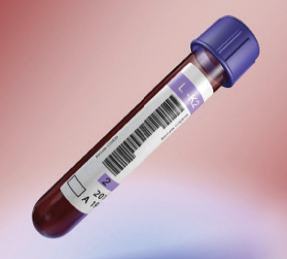
Traditionally, it takes a long time for biomarkers to be validated, let alone for a therapy trial to be completed.
Image Credit: Pasieka/sciencesource.com
ROME, Italy—The traditional approach to trials to assess new biomarkers and related treatments has largely been inefficient, and a better strategy is needed to make stratified treatment available for patients more quickly, an expert said at EULAR 2015, the annual congress of the European League Against Rheumatism (EULAR).
Mahesh Parmar, PhD, director of the Medical Research Clinical Trials Unit at the University College London, has helped develop a more sophisticated trial design in oncology—the field, as he put it, that might be the “poster child” for biomarkers predicting drug response.
In oncology, some of the problems with trials on biomarkers traditionally is that it takes a long time for biomarkers to be validated, let alone for a therapy trial to be completed; there is little that’s gained for the biomarker-negative groups in the trials; and so many of the trials end unsuccessfully.
“By and large, we’ve been typically wrong about a potential link between a biomarker, a treatment and a disease,” Dr. Parmar said. “We’ve been wrong much, much more often than we’ve been right. And if that’s true in oncology, it’s probably likely to be true—in spades—in rheumatoid arthritis. So be ready for lots of stratified medicine trials to show negative results.”
Focus4
The more sophisticated design at University College London, called Focus4, is a colorectal cancer trial that essentially multi-tasks by assessing several biomarkers and related therapies using trials within a trial.
There are five arms on the trial: one on each of four suspected biomarkers that haven’t been fully characterized or fully validated, and a fifth with patients that don’t test positive for any of the biomarkers.
The patient pool for each arm is “enriched” with patients with that biomarker, but it is not a biomarker-positive or negative arrangement. A full biomarker panel is done on all patients; if they’re positive for a certain biomarker, they’ll go into that arm of the trial.
If a patient passes two “lack of activity” stages, they move on to the Phase 3 stage to evaluate whether the biomarker is specific to that treatment. If they don’t pass those stages, another arm is considered, if that’s appropriate.
The design maximizes the possibility of finding promising new treatments and rejecting those that are minimally active, Dr. Parmar said. The umbrella structure also makes it more feasible for less common biomarkers to be tested.
“If we want to make faster progress,” Dr. Parmar said, “if we want not just a series of negative results from lots of individual biomarker-defined stratified trials, we need to think more strategically.”
Window of Opportunity
In another talk, Bernard Combe, MD, PhD, professor of rheumatology at the University of Montpellier in France, said the holy grail of stratified medicine that’s tailored to the needs of a specific patient in daily practice has been elusive, but there are increasingly reliable factors that can be used to help make treatment decisions. He said the goal of treatment should be the “right drug for the right disease at the right time.”
“We currently have no valid predictive factors which have been identified to [guide] the choice of a specific treatment in daily practice,” he said. “However, we may select therapeutic strategies based on baseline predictive factors of outcome, autoantibodies, control of disease activity, patient profile and patient preferences.”
One fairly recent study—an analysis of the French ESPOIR cohort data of RA patients treated with disease-modifying anti-rheumatic drugs—showed how a single factor can drastically change the likelihood that an RA patient will respond to methotrexate, for instance. A patient with elevated CRP, a high swollen joint count and who is ACPA positive, but shows no erosion on X-ray, was found to have a 33% risk of radiographic progression. But that same patient with erosion was found to have a 64% risk.1
Other studies have shown the apparent importance of response at the start of treatment, suggesting that a “window of opportunity” exists in the early phase of disease, Dr. Combe said.
A different analysis of the ESPOIR data showed drastic differences between patients with sustained DAS28 remission after one year of treatment and those with persistent moderate disease activity after a year. More than 80% of those in remission after a year were in DAS28 remission after 5 years, compared to 39% in the other group. The real-life effects were striking: 45 days of work missed over five years in the group in remission after a year, compared with 272 in the other group.2
“Earlier response is a very good indicator of achieving a remission state at one year,” Dr. Combe said.
Gene Classifications
Michael Townsend, PhD, senior scientist at Genentech, discussed progress by researchers there in classifying gene sets and using those classifications to help predict treatment response.
Using samples in early RA from knee joint synovium, researchers have developed a scoring system to describe the samples as “lymphoid,” “myeloid” or “fibroid,” and have used those classifications to help predict treatment response.
Dr. Townsend emphasized that the samples don’t fall neatly into discrete groups, but rather are described according to their place in the “continuum of pathophysiology.”
Researchers have found that synovial samples with the myeloid phenotype are elevated in those with an ACR50 response to anti-TNF-alpha (infliximab) therapy.
They then delved further and found that the ICAM-1 gene is associated with an enhanced response to anti-TNF-alpha therapy and the CXCL13 gene is linked with an enhanced response to anti-IL-6 (tocilizumab) therapy. Dr. Townsend added that this is just the beginning of the effort to find more specific markers.
“We don’t think that all the targeted therapies work in the same patients,” he said. “Different mechanisms may work optimally in different patients….This work’s ongoing to build better predictive marker profiles.”
These findings might show a way forward to improve upon the very similar response rates—most drugs tend to achieve ACR50 rates in the 40% range—that have been seen with biologic therapies, he said.
“Do we want to develop another drug that does the same as what is already there?”
Thomas R. Collins is a freelance medical writer based in Florida.
References
- Fautrel B, Granger B, Combe B, et al. Matrix to predict rapid radiographic progression of early rheumatoid arthritis patients from the community treated with methotrexate or leflunomide: Results from the ESPOIR cohort. Arthritis Res Ther. 2012 Nov 19;14(6):R249.
- Van Nies JAB, Tsonaka R, Gaujoux-Viala C, et al. Evaluating relationships between symptom duration and persistence of rheumatoid arthritis: Does a window of opportunity exist? Results on the Leiden Early Arthritis Clinic and ESPOIR cohorts. Ann Rheum Dis 5 Jan 2015 [Epub ahead of print].
